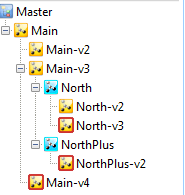Example hierarchy for objects under version control
The example below illustrates the way in which a version controlled object may evolve. The example is based on a network called Main.

The Main network is the original version of the network. This has been superseded by several new versions. The first time the network was checked out for editing a network called Main-v2 was created. Once the user had finished making changes, Main-v2 was checked in. With further changes needed, Main-v2 was checked out and this created Main-v3. Main-v3 in turn formed the basis for the current version of the network, Main-v4.
As a result, there are now four successive versions of Main, each containing additional changes, the latest of which is Main-v4. The icon for Main-v4 is outlined in red to denote that it is still checked out. Any new version of the network must be based on Main-v4 after Main-v4 has been checked in.
In order to test alternative changes to the network, two new networks have been created based on Main-v3, using the Check out and branch command. These new networks are called North and South.
Additional changes have also been made to the North network, including another alternative scenario branched as NorthPlus.
The database now contains four distinct networks:
| Network | Current version |
|---|---|
|
Main |
Main-v4 |
|
North |
North-v3 |
|
NorthPlus |
NorthPlus-v2 |
|
South |
South |
Hierarchy display
The hierarchy in the tree is determined by the following rules:
- New objects and non-branched subsequent versions are displayed in yellow. New branches are displayed in blue.
- A new object, whether a new blank object or an imported object, appears immediately below the Model Group
- The first object created using Check out from a new object appears one level below the new object in the tree. An example above is Main-v2. These are displayed in yellow.
- Subsequent versions of an object appear at the same level as the object from which it was created. The versions appear in the tree in the order in which they were created. In the above tree Main-v3 and Main-v4 are two examples. These are displayed in yellow.
- An object created using Check out and branch is displayed in blue one level below the object from which it is branched. In this example, North, NorthPlus and South are branched.
- When more than one branch is made from an object, these are shown in the order in which they were created. See North and South above.
- The first version created from a branched object appears in yellow, one level below the object from which it was checked out. See North-v2 and NorthPlus-v2 in the example above. Subsequent versions of these objects appear at the same level (as in rule 4).
- An object created using Duplicate appears in blue (indicating that it is a branch), immediately below the model group specified by the user.
These rules may not appear immediately intuitive but have been arrived at as a result of extensive experimentation and user feedback.
